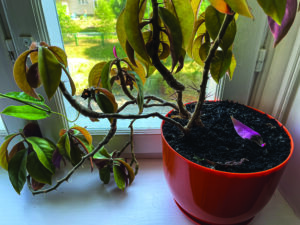
It’s imperative to make sure your indoor plants are getting enough light as the days get shorter. You need to protect them from cold, drafty windows.
Happy fall, fellow gardeners! It’s finally here: Now’s the best time to plant.
You heard me right: Fall is better for planting than spring. Why? In autumn, the ground is still warm whereas in the spring the ground has to gradually unthaw.
The cooler temperatures are fantastic for us, and they also lend to weeds slowing down in growth — making fall the best time to plant.
The days are getting shorter, and the sun is setting sooner which means the first frost is creeping up on us.
For example, in Easton, the risk of frost really begins around Oct. 19, and by Nov. 16 is when we’re almost certain to have received at least one frost event.
Hardy mums, pansies and ornamental cabbage, kale and peppers should be planted now so that they’ll become more established before winter.
It’s also time to plant your spring-flowering bulbs like daffodils, alliums and tulips.
Plant them in a sunny spot, in well-drained soil. Tulip bulbs should be planted from mid-October through November.
Use Bone Meal or Bulb Tone at the time of planting.
While some flowers blooms are ending, many pollinators will still need food and shelter through the fall while they’re preparing for winter.
Goldenrods and asters are two plants native to our area that are fantastic food sources for our six-legged friends.
Take advantage of the beautiful weather and cut back perennial foliage after a killing freeze to make the plants ready for the next growing season.
Plan ahead and divide and move any perennials that have gotten too large. Fall is a great time for feeding plants before they go dormant.
Plant food brands such as the Espoma Bio-Tone line offers products with beneficial microbes, which help the plant to develop deeper roots, and superior blooms.
They provide a complete and balanced feeding using only natural ingredients, not using harmful salts or other man-made elements which are harmful to the environment and plants. There is a “tone” for every plant — bulb, citrus, garden, tomato, berry, tree, flower, rose, holly, and all-purpose Plant Tone.
This season is better for your plants, but it’s also better for you. Being in the garden is made much easier with dropping temperatures, so you’re not outside risking a heat stroke.
Now’s the time to clean and sharpen up your garden tools before putting them away. I’d also recommend using deer deterrent at this time.
Whether you plant natural deterrents, such as marigolds, or use a spray every three to four weeks, try alternating varieties to keep deer confused.
If they’re not smelling familiar scents, they’re much less likely to return.
Additionally, if you have a pond feature and haven’t done so yet, it should be covered with netting to prevent leaves and other debris from falling in.
When cleaning up your garden, dispose of any diseased or infected plants in the trash — do not compost.
Check for bagworms, pick them off, and dispose of them, too.
These temperatures also make mulching and fertilizing much more pleasant.
Milorganite is a favorite of mine. It’s Chesapeake Bay-friendly organic fertilizer utilized by many golf courses.
For houseplants summering outdoors, if you haven’t done so yet, they need to be sprayed with insecticidal soap every seven to 10 days, for three applications.
This will kill any pests and prevent them from spreading to your indoor plants. After this is complete, it’s finally time to bring them inside.
Be sure to slow down on watering. If you usually water once a week, only water when soil is dry to the touch.
It’s also imperative to make sure your indoor plants are getting enough light as the days get shorter.
You need to protect them from cold, drafty windows.
If the room they’re kept in is cooling off, consider moving them to a room that holds heat better, or consider a space heater (but make sure to leave the space heater unplugged when you’re not home).
Try not to repot anything unless absolutely necessary. Repotting stimulates new growth, which is not ideal as your plants are entering their dormancy. Finally, don’t forget about humidity.
Fall means drier air in our homes, which our plants aren’t a fan of.
Brown leaf tips and margins are a sign your air is too dry.
This can be fixed by running a cool-mist humidifier near them.
Good luck with your garden this October.
(Editor’s Note: Ken Morgan is the owner of Robin’s Nest Floral and Garden Center in Easton, Md.)



